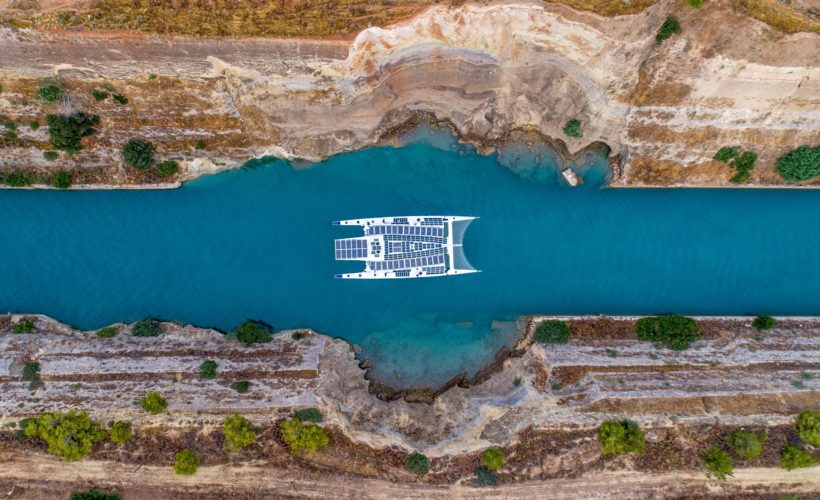Victorien Erussard, an experienced ocean racer from the city of Saint-Malo in the north of France, was halfway through a dash across the Atlantic when he lost all power. Sails kept the boat moving, but Erussard relied on an engine and generator to keep the electronics running. He temporarily lost his autopilot and his navigation systems, jeopardizing his chances of winning the 2013 Transat Jaques Vabre race.
Never again, he thought. “I came up with the idea to create a ship that uses different sources of energy,” he says. The plan was bolstered by the pollution-happy cargo ships he saw while crossing the oceans. “These are a threat to humanity because they use heavy fuel oil.”
Five years on, that idea has taken physical form in the Energy Observer, a catamaran that runs on renewables. In a mission reminiscent of the Solar Impulse 2, the solar-powered plane that Bertrand Picard and André Borschberg flew around the world a few years back, Erussard and teammate Jérôme Delafosse are planning to sail around the planet, without using any fossil fuel. Instead, they’ll make the fuel they need from sea water, the wind, and the sun.
The Energy Observer started life as a racing boat but now would make a decent space battle cruiser prop in a movie. Almost every horizontal surface on the white catamaran is covered with solar panels (1,400 square feet of them in all), which curve gently to fit the aerodynamic contours. Some, on a suspended deck that extends to the sides of the vessel, are bi-facial panels, generating power from direct sunlight as well as light reflected off the water below. The rear is flanked by two vertical, egg whisk-style wind turbines, which add to the power production.
Propulsion comes from two electric motors, driven by all that generated electrical energy, but it’s the way that’s stored that’s clever. The Energy Observer uses just 106-kWh (about equivalent to a top-end Tesla) of batteries, for immediate, buffer, storage and energy demands. It stores the bulk of the excess electricity generated when the sun is shining or the wind is blowing as hydrogen gas. An electrolyzer uses the current to spilt the water into hydrogen and oxygen. The latter is released into the atmosphere, and the H2 is stored in eight tanks, made from aluminum and carbon fiber, which can hold up to 137 pounds of compressed hydrogen. When that energy is needed, the H2 is run through a fuel cell and recombined with oxygen from the air to create electricity, with water as a byproduct. That’s the same way fuel cell cars, like the Honda Clarity and Toyota Mirai work.
By storing energy this way instead of with banks of batteries, Erussard made the Energy Observer three times lighter than the similarly sized MS Tûranor PlanetSolar, which became the first boat to circumnavigate the globe using only solar power in 2012.
And the new vessel is kind to the ears as well as the planet. “There’s zero sound pollution, it’s a true pleasure to navigate on this vessel,” Erussard said on stage at the recent Movin’On future mobility conference in Montreal, Canada.
Inside there’s a gleaming white helm, with two captains chairs, and living quarters that wouldn’t look out of place in 2001: A Space Odyssey, with an almost harshly minimalist white design. The team designed the furnishings to be as light as possible too, because a lighter boat uses less energy, and so is more efficient.
The team isn’t rushing things. The mission started in June 2017, and will last six years, reach 50 countries, and make 101 stops. The vessel has already travelled 7,000 nautical miles, to port cities around the French coast, and is now in the Mediterranean. It’s due to arrive in Venice on July 6, and spend 10 days in port, where the crew will meet the public, and hold set up an interactive exhibit to showcase environmentally technologies.
“The idea with this ship is to prove a potential energy system of the future,” Erussard says. He’s determined that the same types of energy generation and storage that he’s using onboard could be used on land too, to reduce dependence on fossil fuels, and maybe one day to clean up those container ships he’ll pass en route.
More Great WIRED Stories
- PHOTO ESSAY: These flowers are actually fireworks
- How Tesla is building cars in its parking lot
- The new arms race threatening to explode in space
- How technology helped me cheat dyslexia
- The next generation of Wi-Fi security will save you from yourself
- Hungry for even more deep-dives on your next favorite topic? Sign up for the Backchannel newsletter
Source:WIRED











